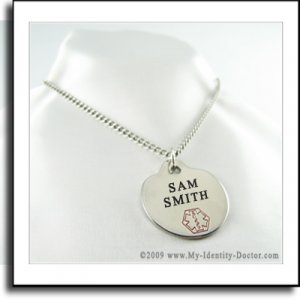 As a form of assistance and notification, people with medical conditions may wear or carry a form of medical identification, usually a wrist band, bracelet or necklace.
As a form of assistance and notification, people with medical conditions may wear or carry a form of medical identification, usually a wrist band, bracelet or necklace.
 As a form of assistance and notification, people with medical conditions may wear or carry a form of medical identification, usually a wrist band, bracelet or necklace.
As a form of assistance and notification, people with medical conditions may wear or carry a form of medical identification, usually a wrist band, bracelet or necklace.
These medical-alert devices are imprinted with the person's identity, the relevant medical condition, allergies, drugs required and specialised medical contact information.
Medical conditions that may be shown vary from specific heart diseases, to diabetes, epilepsy, asthma and serious allergies.
The psychological value of reassurance is as important in first aid as the treatment that you give. Comfort and reassure the casualty, as in some cases all the casualty needs is emotional support and reassurance.
A calm approach by the first aider and keeping the casualty informed of what is happening will also assist in the reassurance process.
Remember many people who have assisted you in delivering care to an injured or ill casualty may need reassurance themselves. Relatives of the casualty may be concerned they let the casualty down or made a mistake in not getting help earlier; workmates may feel they contributed little to helping the casualty; onlookers may feel guilty they provided little practical assistance.
Take some time out at the end of the incident to tell people how important their contribution was. Let them know that effectively caring for a casualty is a team effort and every little job counts. This is especially true if the outcome of the emergency was unsuccessful.
"Cultural awareness" is understanding the likely impact of your behaviour and beliefs on health, illness and care. Ensure you obtain permission to examine a casualty or provide treatment.
You should always treat the casualty with respect and observe their rights not to be touched or treated.
An emergency of any size can cause unusual stress in people who have been directly and indirectly affected by it. Every person will react differently and a range of responses to an emergency is normal and to be expected.
Emotional responses to disasters can appear immediately or sometimes months later. Understanding what you're feeling and taking positive steps can help you cope with this disaster.
Some common responses to emergencies and disasters are:
If you have strong feelings that won't go away or if you are troubled for longer than four to six weeks, you may want to seek professional help.
After an incident it is important to put some time aside for yourself. Very often first aiders become concerned they did not do a good enough job and they were not effective in their role.
When you think about how you handled the incident, the first thing you should keep in mind is that by stepping forward and offering first aid you have done more for the casualty than anyone else could ever do. As the great humanitarian Albert Schweitzer said,
"The purpose of this life is to serve and show compassion and the will to help others."
In dealing with this, go and get a cup of tea and talk to a family member, friend or colleague. When you go over how you handled the incident be realistic about your expectations. Time must also be allocated to the clean-up of the scene and equipment and to restock your first aid kit.
You should: